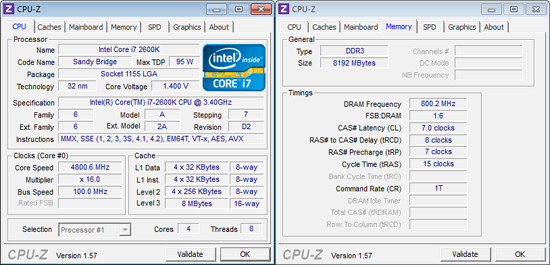System Builder Marathon, March 2011: $2000 Bonus Build
CPU And DRAM Overclocking
The same 1.40 V core limit was chosen for both the new and previous build, since we’re still a little concerned about the short-term deterioration that we’ve seen at 1.45 V or more. Once again, the processor seemed eager to shoot to 5.00 GHz, though extended testing proved it was only stable over the long term at 4.80 GHz.


Increased memory frequencies were far more difficult to achieve using this motherboard, though we might have had worse luck with the second set of memory modules. After a lengthy battle to repeat a stable DDR3-1866 CAS 8-9-8 from our previous build, we were forced to settle for DDR3-1600 CAS 7-8-7.


The P67A-GD65 (B3) responded to our overclock by disabling C1E and EIST. Doing so drastically increases low-load power consumption, while providing minimal benefits in performance consistency. We re-enabled these features.
Using the “Low VDroop” setting from BIOS along with its 1.376 V CPU Core setting allowed our CPU to increase from 1.34 V at low load to 1.40 V at high load.
Current page: CPU And DRAM Overclocking
Prev Page Component Installation And GPU Overclocking Next Page Test SettingsGet Tom's Hardware's best news and in-depth reviews, straight to your inbox.
-
Great SBM series. What about an AMD quad core vs. an AMD triple core (unlocked 4th core) vs. Core i3 value comparison?Reply
-
compton Now this is pretty interesting. I wouldn't have suspected that the memory bandwidth reduction in the alternate build would have been as big of deal as it is. I think both builds are fantastic, but the NF200-equiped Asus board was one I myself was trying to obtain. It has been deactivated on the Egg, and the winner of the original $2000 build will be extra lucky indeed. Hopefully, it's me.Reply -
Crashman comptonNow this is pretty interesting. I wouldn't have suspected that the memory bandwidth reduction in the alternate build would have been as big of deal as it is. I think both builds are fantastic, but the NF200-equiped Asus board was one I myself was trying to obtain. It has been deactivated on the Egg, and the winner of the original $2000 build will be extra lucky indeed. Hopefully, it's me.It was deactivated, but has since been reactivated:Reply
http://www.newegg.com/Product/Product.aspx?Item=N82E16813131714
Now when you win the second PC, there will be no need for sadness: You can upgrade it with the motherboard from the first!
-
wolfram23 I'd love to see more info on 16x/16x vs 8x/8x. I just looked at the last time you guys reviewed it, but it was only with a GTX480. Being one of many with a P55 8x/8x mobo, I really need to know what my best upgrade path would be... single top end card at 16x? Or CF/SLI again? Is the resolution going to be the deciding factor? Seems like high res sees less of a PCIe bottleneck at 8x, but maybe it's just due to framerates being lower? Need info! lol.Reply -
Crashman Wolfram23I'd love to see more info on 16x/16x vs 8x/8x. I just looked at the last time you guys reviewed it, but it was only with a GTX480.Look for something in a week or two. And you're right to NOT bother with the GTX480 stuff, Nvidia cards need less bandwidth than AMD cards.Reply
-
compton ReplyIt was deactivated, but has since been reactivated:
http://www.newegg.com/Product/Prod 6813131714
Now when you win the second PC, there will be no need for sadness: You can upgrade it with the motherboard from the first!
This is why the SBM is the best thing going. A few other sites do similar articles, but Tom's is far and away the champion. Another well respected site doesn't even build the systems, but Tom's builds three (or four!) and gives 'em away like sweet delicious candy. Every build has its's own quirks, issues, and performance wins (losses too) that can't always be understood until the gear arrives and goes together. If system building was entirely predictable, no one would build their own. It's just more fun this way.
-
qwertymac93 antec 300 again... im really not liking that case. you have any experience with the haf 912? it seems like a very nice case.Reply
Anyway, i never understood why intel went with just 16 lanes on SB yet all the mobo makers market their ultra high end cross fire boards. :pt1cable:
Thing I'm wondering is, if intel switched to 24 lanes, could the graphics cards work at 12x each for 2 way, and 8x for 3 way? i know a full 32 lanes is unlikely, that's why I'm asking.


